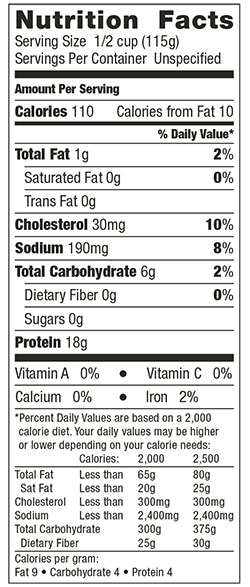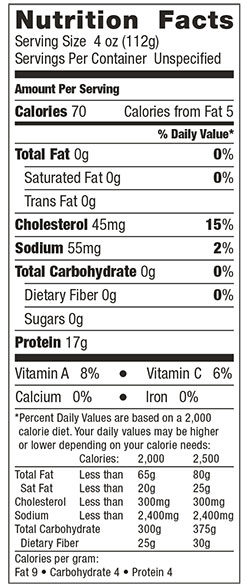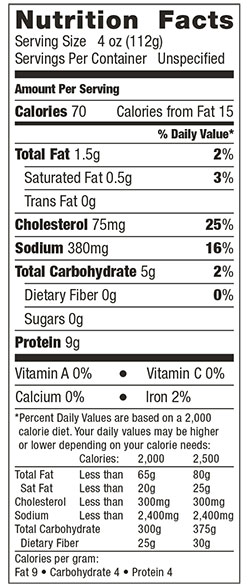Nutrition
The USDA and U.S. Department of Health and Human Services Dietary Guidelines recommend eating seafood twice a week (at least 8 ounces per week) for optimum health.
With a great selection of delicious seafood to choose from – sustainable, available, affordable, and easy to prepare – there are a lot of good reasons to have an assortment of healthy seafood on your menu and in your retail case all year long.
Scallops Nutrition
Scallops are enjoyed for their sweet, buttery flavor and can boast plenty of nutritional value. They are a great source of lean protein and are naturally low in fat and calories. One 3-ounce serving of steamed sea scallops offers 17 grams of protein and approximately 100 calories. Scallops are also rich source of B-12, which helps to maintain a healthy nervous and cardiovascular system.

In addition to B12, scallops are a good source of magnesium and potassium, two other nutrients that provide significant benefits for the cardiovascular system. Magnesium helps out by causing blood vessels to relax, thus helping to lower blood pressure while improving blood flow. Potassium assists in maintaining normal blood pressure levels. The high quality protein in the scallop contains essential amino acids, organic molecules that cannot be produced by our body, as well as minerals such as copper, iron and zinc. Scallops also contain Omega 3 fatty acids, which are derived from the phytoplankton that are a source of food for scallops. The exact amount of Omega 3 fatty acids can vary depending on the scallops diet, the season and location of harvest.
Pacific Cod Nutrition
Pacific cod is a flaky, white meat fish and an excellent low-calorie source of protein; a 100-gram serving (approximately 3.5 ounces) of a steamed fillet contains 18 grams of healthy protein and only 82 calories.
Cod is a good source of Omega 3 fatty acids. These essential fatty acids, EPA and DHA, are found in fish oil. Ensuring you have EPA and DHA fatty acids in your diet may reduce the risk of developing cardiovascular disease by preventing inflammation and reducing cholesterol and other fats in the blood stream. A 3-ounce serving of Pacific cod has 0.14 grams of combined EPA and DHA fatty acids.
Pacific cod is also a great source for vitamin B-12. It contains a significant amount of the vitamin, with 33 percent of the Daily Value (DV) per serving, and 6 percent of the DV for vitamin B-6. The B vitamins help to remove the amino acid homocysteine, which in high levels may be damaging to blood vessel walls. Cod is also a good source of niacin, another B vitamin that is used to help lower high cholesterol levels.
Loaded with heart healthy benefits and low in fat and calories Cod is an excellent choice for a healthy and delicious center of the plate protein.
Flatfish Nutrition
Flounder and sole are probably the two most recognizable flatfish species. The mild tasting fish is a great middle of the plate protein. The flaky white fillets are well suited for many different recipes from pan seared or baked fish to tacos and chowders.
Low in fat and calories, flounder is lean and protein rich. A 6-ounce serving of flounder offers more than 30 grams of complete protein. Flounder and sole contain all 9 of the essential amino acids (histidine, isoleucine, leucine, lysine, methionine, phenylalanine, threonine, tryptophan and valine). Amino acids are used to make proteins to aid the body in breaking down our food, repairing body tissue, supporting muscle growth and many other body functions. Because our bodies do not produce the essential amino acids, they must come from our diet. And unlike fats and starch, our bodies do not store amino acids so they must be taken in by the food we eat daily.
Flounder is low in cholesterol. And, although it is not a high source of Omega 3 fatty acids, it is a good source of lean protein. Flatfish species are also a good source of niacin, B vitamins, phosphorus, calcium and selenium.
Served with whole grains and green leafy vegetables, it makes a low fat and nutritional rich meal and is a heart-healthy way to add essential nutrients to your diet.


